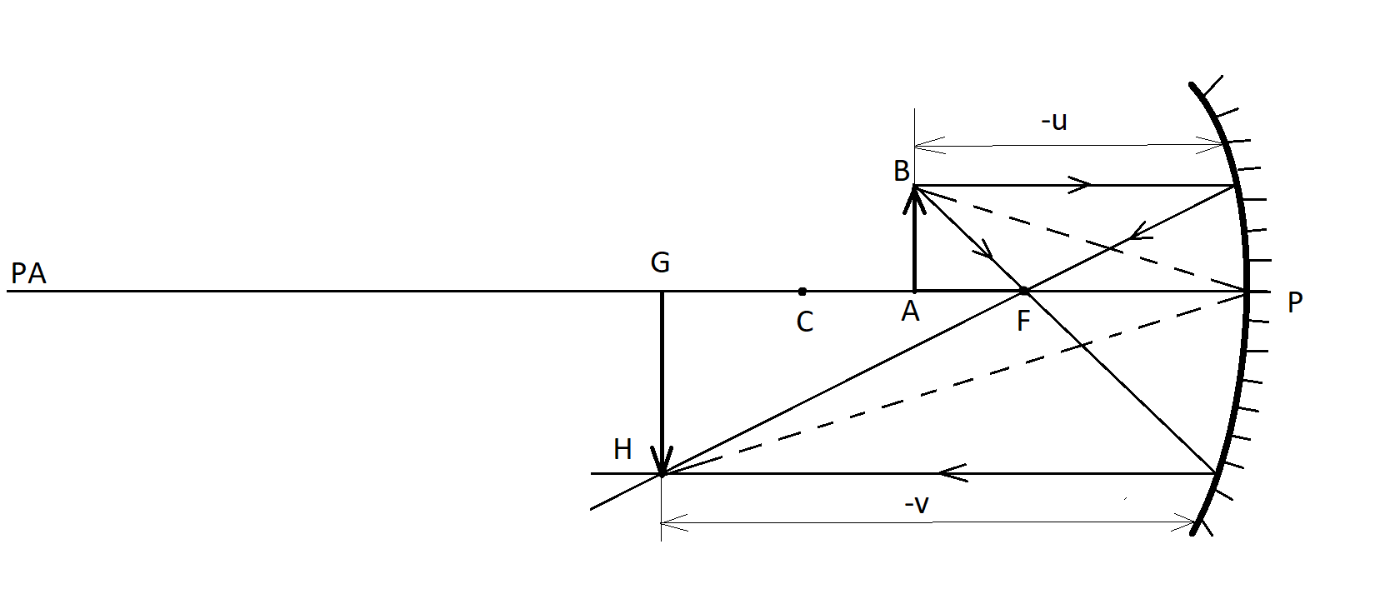
The magnification for a mirror is -3. How are u and v related?
Answer
143.1k+ views
1 likes
Hint: Before we understand the concept of magnification in a mirror, it is important to understand the magnification is only possible in curved mirrors. In plane mirrors, the magnification is always 1 which means that the image is not enlarged or diminished in a plane mirror and always has the same size of the object. Hence, we have to consider curved mirrors only.
Complete step by step answer:
Magnification of the image is defined as the ratio of height of the image produced by the curved mirror to the ratio of height of the object.
Let us consider an object AB of height

There are two rays emerging from the object.
i) First ray, parallel to the principal axis PA, after reflection, passes through focus.
ii) Second ray, passing through focus, after reflection, passes parallel to the principal axis.
These two rays meet beyond the centre of curvature C, to form the image GH of height
Consider the triangles ABP and GHP.
By the law of reflection that incident angle equal to reflected angle, we have –
Hence, we can prove that the triangles ABP and GHP are similar.
By rule of similarity, we can say that –
Given that
Magnification is equal to the ratio of height of image of height of object.
Substituting,
Therefore, magnification is defined as the ratio of v to u with a minus sign.
Note: The formula for the magnification in a lens is the same as that of a mirror, but only in the magnitude. The magnification formula for lenses has a positive sign while the magnification formula for a mirror has a negative sign.
Magnification for lens –
The students must understand the clear distinction between the two so that there is no confusion between the two formulae.
Complete step by step answer:
Magnification of the image is defined as the ratio of height of the image produced by the curved mirror to the ratio of height of the object.
Let us consider an object AB of height

There are two rays emerging from the object.
i) First ray, parallel to the principal axis PA, after reflection, passes through focus.
ii) Second ray, passing through focus, after reflection, passes parallel to the principal axis.
These two rays meet beyond the centre of curvature C, to form the image GH of height
Consider the triangles ABP and GHP.
By the law of reflection that incident angle equal to reflected angle, we have –
Hence, we can prove that the triangles ABP and GHP are similar.
By rule of similarity, we can say that –
Given that
Magnification is equal to the ratio of height of image of height of object.
Substituting,
Therefore, magnification is defined as the ratio of v to u with a minus sign.
Note: The formula for the magnification in a lens is the same as that of a mirror, but only in the magnitude. The magnification formula for lenses has a positive sign while the magnification formula for a mirror has a negative sign.
Magnification for lens –
The students must understand the clear distinction between the two so that there is no confusion between the two formulae.
Latest Vedantu courses for you
Grade 10 | MAHARASHTRABOARD | SCHOOL | English
Vedantu 10 Maharashtra Pro Lite (2025-26)
School Full course for MAHARASHTRABOARD students
₹33,300 per year
EMI starts from ₹2,775 per month
Recently Updated Pages
How to find Oxidation Number - Important Concepts for JEE

How Electromagnetic Waves are Formed - Important Concepts for JEE

Electrical Resistance - Important Concepts and Tips for JEE

Average Atomic Mass - Important Concepts and Tips for JEE

Chemical Equation - Important Concepts and Tips for JEE

Concept of CP and CV of Gas - Important Concepts and Tips for JEE

Trending doubts
JEE Main Exam Marking Scheme: Detailed Breakdown of Marks and Negative Marking

Physics Average Value and RMS Value JEE Main 2025

Electrical Field of Charged Spherical Shell - JEE

Geostationary Satellites and Geosynchronous Satellites - JEE Important Topic

JEE Main 2025: Conversion of Galvanometer Into Ammeter And Voltmeter in Physics

The perfect formula used for calculating induced emf class 12 physics JEE_Main

Other Pages
JEE Advanced 2025 Revision Notes for Practical Organic Chemistry

A Zener diode having breakdown voltage equal to 15V class 12 physics JEE_Main

JEE Advanced 2025 Revision Notes for Physics on Modern Physics

JEE Advanced Course 2025: Subject List, Syllabus and Foundation Course

Reading of ammeter in ampere for the following circuit class 12 physics JEE_Main

JEE Advanced Live Classes for 2025 By Vedantu




